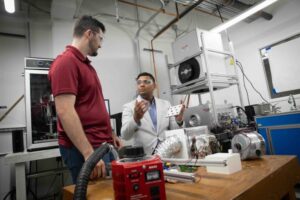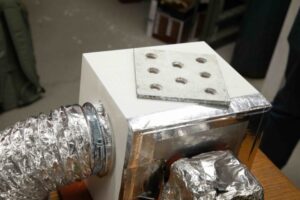
Earth’s atmosphere holds an ocean of water, enough liquid to fill Utah’s Great Salt Lake 800 times.
Extracting some of that moisture is seen as a potential way to provide clean drinking water to billions of people globally who face chronic shortages.
Existing technologies for atmospheric water harvesting (AWH) are saddled with numerous downsides associated with size, cost and efficiency. But new research from University of Utah mechanical engineering researchers has yielded insights that could improve efficiencies and bring the world one step closer to tapping the air as a culinary water source in arid places.
The study unveils the first-of-its-kind compact rapid cycling fuel-fired AWH device. This two-step prototype relies on adsorbent materials that draw water molecules out of non-humid air, then applies heat to release those molecules into liquid form, according to Sameer Rao, senior author of the study published Monday and an assistant professor in the John and Marcia Price College of Engineering.
“Hygroscopic materials intrinsically have affinity to water. They soak up water wherever you go. One of the best examples is the stuff inside diapers,” said Rao, who happens to be the father of an infant son. “We work with a specific type of hygroscopic material called a metal organic framework.”

Rao likened metal organic frameworks to Lego blocks, which can be rearranged to build all sorts of structures. It this case they are arranged to create a molecule ideal for gas separation.
“They can make it specific to adsorb water vapor from the air and nothing else. They’re really selective,” Rao said. Developed with graduate student Nathan Ortiz, the study’s lead author, this prototype uses aluminum fumarate that was fashioned into panels that collect the water as air is drawn through.
“The water molecules themselves get trapped on the surfaces of our material, and that’s a reversible process. And so instead of becoming ingrained into the material itself, it sits on the walls,” Ortiz said. “What’s special about these absorbent materials is they have just an immense amount of internal surface area. There’s so many sites for water molecules to get stuck.”
Just a gram of this material holds as much surface area as two football fields, according to Rao. So just a little material can capture a lot of water.
“All of this surface area is at the molecular scale,” Rao said. “And that’s awesome for us because we want to trap water vapor onto that surface area within the pores of this material.”
Continue reading Brian Maffly’s “Producing Water Out of Thin Air” @theU.